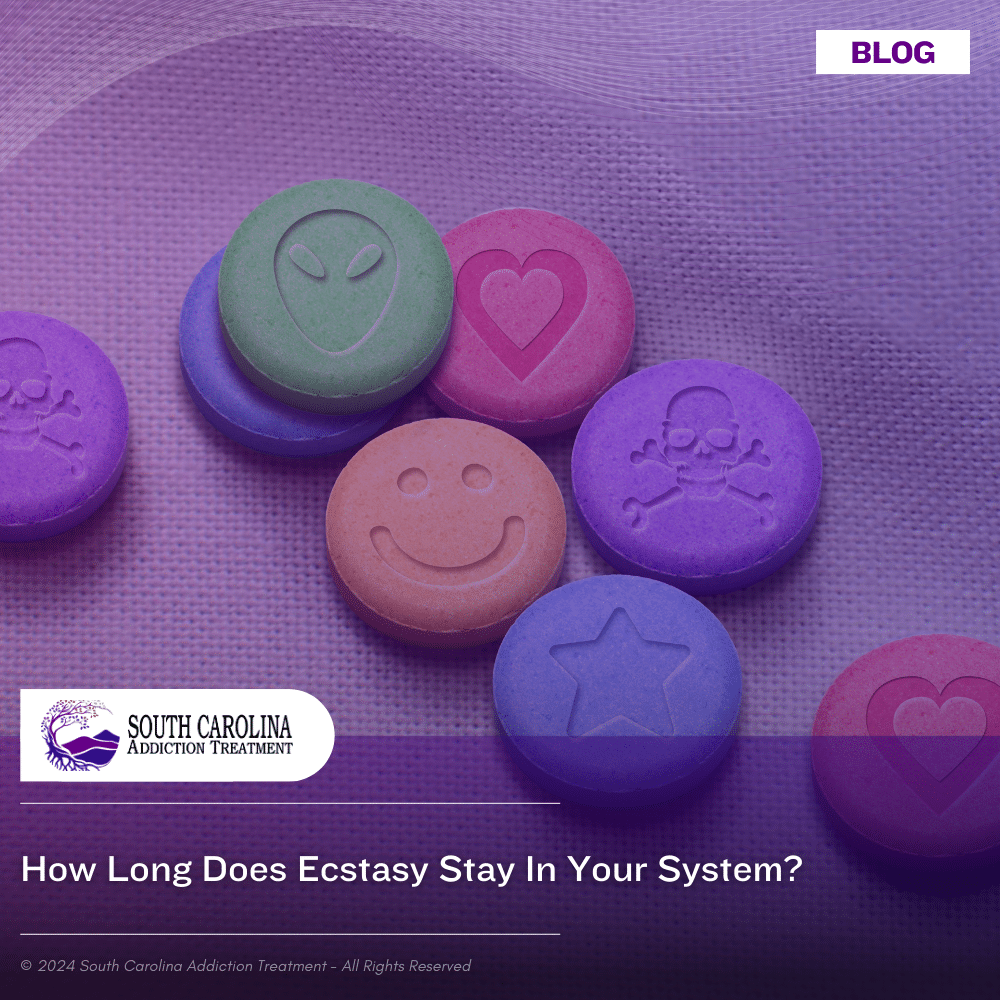How Long Does Ecstasy Stay in Your System?

Medically Verified: 2/1/24
Medical Reviewer
Chief Editor

All of the information on this page has been reviewed and verified by a certified addiction professional.
Ecstasy is a slang term for a synthetic drug known as MDMA. Also referred to as molly, ecstasy can cause both stimulant and hallucinogenic effects. People who abuse ecstasy do so to experience increased energy, heightened sensory perceptions, feelings of closeness with others, and more.
According to the National Institute of Drug Abuse (NIDA), 2.2 million people reported abusing ecstasy in 2021.[1]
While ecstasy remains in your system for 16 to 18 hours, drug tests can find its metabolites in your body for up to 90 days depending on the type of test being conducted. However, ecstasy is not included on a standard drug panel, which means a specialized test must be used.
How Long Do the Effects of Ecstasy Last?
Ecstasy can cause a variety of effects that stem from the way the drug interacts with dopamine, serotonin, and norepinephrine receptors in your brain. These three chemicals are responsible for your mood, energy level, feelings of trust, sexual drive, emotions, and sleep, which is why MDMA can cause euphoria, warm emotions, heightened sensory perceptions, and sexual desire.
The effects of ecstasy will begin 30 to 45 minutes after you consume it, lasting up to 3 to 6 hours. These effects include:[2]
- A rush of euphoria
- Emotional warmth
- Feelings of openness and trust
- Heightened sense of touch, sound, and smell
- Dry mouth
- Clenching of the jaw
- Muscle tension
- Nausea and vomiting
- Increased sweating and dehydration
- Increased energy
- Blurred vision or light sensitivity
After the effects of ecstasy wear off, you might begin to experience something known as a “comedown.” Since it increases your serotonin levels, they will drop once the drug wears off, resulting in feelings of depression, anxiety, memory issues, decreased attention, and sleep disturbances.
How Long Does Ecstasy Stay in Your System?
A drug’s half-life displays how long it takes your system to eliminate half of it. Typically, it can take 4 to 5 half-lives for a drug to be completely ridden from your body. The half-life of MDMA is between 8 to 9 hours, so it can take almost 2 days for your system to flush it out.[3]
However, metabolites of ecstasy may remain in parts of your body for longer than 2 days. These metabolites are what drug tests look for to determine if you’ve recently consumed MDMA.
Urine
Specialized urine panels can detect ecstasy in your system for up to 4 days. These are the most common tests used for ecstasy testing as they are reliable, relatively affordable, and minimally invasive.
Blood
Blood tests are not used as often as urine tests to detect ecstasy because they are invasive and provide a short window of detection. These tests can find ecstasy in your blood for 1 to 2 days after your last dose.
Saliva
Saliva tests are most often used by police when attempting to discern whether you are under the influence. Saliva tests can detect ecstasy in your system for up to 2 days after you last used it.
Hair
While hair tests are the most reliable, they are expensive to conduct because they are sent to the lab to test for every substance of abuse. Hair tests can detect any substance in your system for up to 90 days, including ecstasy.
Factors that Affect How Long Ecstasy Remains in Your System
Even though most people eliminate ecstasy from their system at a similar timeline, certain factors can increase or even decrease how long it stays in your body. For example, someone who uses ecstasy regularly or at high doses might test positive longer than a first-time user.
Additional factors that affect how long ecstasy remains in your system include:
- The dose you take
- Method of administration (i.e. smoking or snorting)
- How frequently do you use it
- Your BMI
- The rate of your metabolism
- If you take other substances
- Underlying health issues like liver or kidney disease
- Age
- Biological sex
It is important to note that there is no way to flush ecstasy out of your system faster. Methods like drinking a lot of water or exercising will not result in a significant increase in metabolic rate. As a result, the only way to ensure that you do not test positive for ecstasy on a drug test is to avoid using it.
Find Help for Ecstasy Abuse
If you or a loved one regularly abuses ecstasy, it’s time to seek professional help. Drug rehab programs like the South Carolina Addiction Treatment Center can offer you the tools and support you need to maintain long-term sobriety from drugs like MDMA.
To learn more about our addiction treatment center, contact us today.
References:
- The National Institute on Drug Abuse (NIDA): What is the scope of MDMA use in the United States, Retrieved December 2023 From https://nida.nih.gov/publications/research-reports/mdma-ecstasy-abuse/what-is-the-scope-of-mdma-use-in-the-united-states
- The National Institute on Drug Abuse (NIDA): What are the effects of MDMA, Retrieved December 2023 From https://nida.nih.gov/publications/research-reports/mdma-ecstasy-abuse/what-are-effects-mdma
- The National Library of Medicine (NLM): Pharmacology of MDMA in Humans, Retrieved December 2023 From https://pubmed.ncbi.nlm.nih.gov/11085324/

